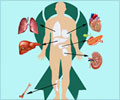The therapeutic effectiveness of stem cell transplantation in treating amyotrophic lateral sclerosis and spinal cord injury has been assessed in animal models.

Transplantation of mesenchymal stem cells (MSCs), multipotent stem cells with the ability to differentiate into a variety of cell types with renewal capacities, has been found to enhance laboratory animal function after induced spinal cord injury. However, the biological mechanism of the functional enhancement has not been clearly defined. In an attempt to gain a clearer picture of the mechanism, a team of Korean researchers transplanted MSCs derived from human umbilical cord blood into the tail veins of laboratory rats immediately after spinal cord injury. The intravenous route was selected because the researchers felt that injection into the damaged site could further traumatize the injured spinal cord, although intravenously injected MSCs risk being eliminated by the host immune system."We found that MSCs express immunomodulatory effects during the acute phase following SCI," said study corresponding author Dr. Sung-Rae Cho of the Yonsei University College of Medicine in Seoul, Korea. "In our study, MSCs suppressed activated micoglia and inflammatory cytokines, increased anti-inflammatory cytokines and, consequently, promoted functional recovery in SCI rats."They reported "modest but significant improvement" in a number of functional test scores in the rats subjected to transplantation when compared with control group animals not subjected to cell transplantation.The researchers suggested that their study not only confirmed the established link between microglial activation and inflammatory cytokines, but also demonstrated that functional recovery might be attributed to immunomodulatory effects rather than cell replacement. They also recommended that autologous (self-donated) MSCs, rather than human-derived MSCs, should be used in subsequent studies to "suppress undesirable immune response."
Contact: Dr. Sung-Rae Cho, Department and Research Institute of Rehabilitation Medicine, Yonsei University College of Medicine, 134 Shinchon-dong, Seodaemun-gu, Seoul, Korea 120-752
Tel: +82 2 2228-3715 Fax: +82 2 363-2795 Email: [email protected]
Citation: Seo, J. H.; Jang, I. K.; Kim, H.; Yang, M. S.; Lee, J. E.; Kim, H. E.; Eom, Y-W.; Lee, D-H.; Yu, J. H.; Kim, J. Y.; Kim, H. O.; Cho, S-R. Early immunomodulation by intravenously transplanted mesenchymal stem cells promotes functional recovery in spinal cord injured rats. Cell Med. 2(2):55-67; 2011.
Bone marrow cell transplantation coupled with stimulating factor offers neuroprotective and angiogenic effects in ALS animal models
In this the first report showing the effects of bone marrow cell transplantation (BMT) combined with granulocyte colony-stimulating factor (GCSF) in mouse models of ALS, researchers from Okayama University, Japan demonstrated that the co-treatment potentially confers neuroprotective and angiogenic (blood vessel growth) effects on the test mice."Combined treatment with BMT and GCSF delayed disease progression and prolonged the survival of G93A mice while BMT or GCSF treatment alone did not," said corresponding author professor Koji Abe of the Department of Neurology in the Okayama University Graduate School of Medicine, Dentistry and Pharmaceutical Sciences. "In addition, the mice treated with BMT and GCSF also showed a reduction in motor neuron loss, induced neuronal precursor cell proliferation, and the increased expression of several neurotrophic factors."Since ALS is a progressive, fatal disease characterized by the loss of motor neurons, motor neuron preservation is critical. According to the researchers, the combination treatment of BMT and GCSF had a greater impact via significant neuroprotective and neuroregenerative effects than when compared to BMT alone.GCSF was administered to not only provide a neuroprotective effect, but also to stimulate the proliferation of bone marrow cells," said Dr. Abe.
Advertisement
Graduate School of M, dentistry and Pharmaceutical Sciences,
Okayama University, 2-5-1 Shikata-cho, Okayama 700-8558, Japan
Tel: 81-86-235-7365 Fax: 81-86-235-7368 Email: [email protected]
Citation: Ohta, Y.; Nagai, M.; Miyazaki, K.; Tanaka, N.; Kawai, H.; Mimoto, T.; Morimoto, N.; Kurata, T.; Ikeda, Y.; Matsuura T.; Abe, K. Neuroprotective and Angiogenic Effects of Bone Marrow Transplantation Combined With Granulocyte Colony-Stimulating Factor in a Mouse Model of Amyotrophic Lateral Sclerosis. Cell Med. 2(2):69-83; 2011
Advertisement
Source-Eurekalert












